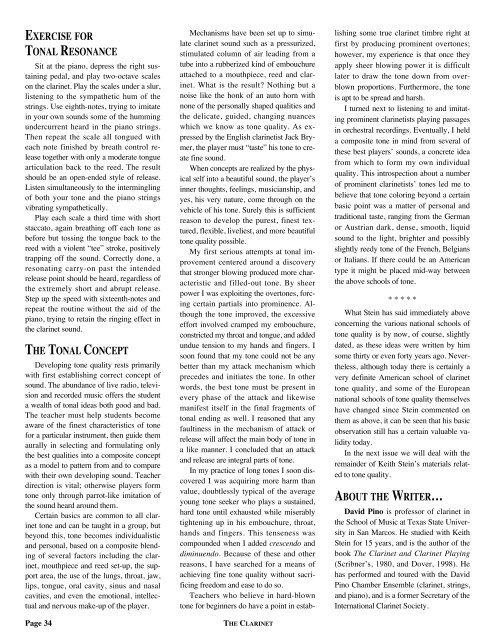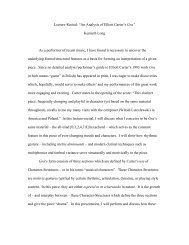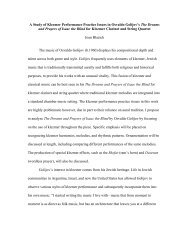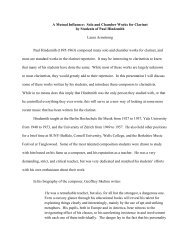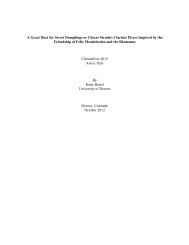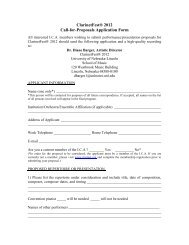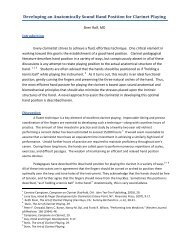Volume 33 Number 3 June 2006 - International Clarinet Association
Volume 33 Number 3 June 2006 - International Clarinet Association
Volume 33 Number 3 June 2006 - International Clarinet Association
- No tags were found...
You also want an ePaper? Increase the reach of your titles
YUMPU automatically turns print PDFs into web optimized ePapers that Google loves.
EXERCISE FOR<br />
TONAL RESONANCE<br />
Sit at the piano, depress the right sustaining<br />
pedal, and play two-octave scales<br />
on the clarinet. Play the scales under a slur,<br />
listening to the sympathetic hum of the<br />
strings. Use eighth-notes, trying to imitate<br />
in your own sounds some of the humming<br />
undercurrent heard in the piano strings.<br />
Then repeat the scale all tongued with<br />
each note finished by breath control re -<br />
lease together with only a moderate tongue<br />
articulation back to the reed. The result<br />
should be an open-ended style of release.<br />
Listen simultaneously to the intermingling<br />
of both your tone and the piano strings<br />
vibrating sympathetically.<br />
Play each scale a third time with short<br />
staccato, again breathing off each tone as<br />
before but tossing the tongue back to the<br />
reed with a violent “tee” stroke, positively<br />
trapping off the sound. Correctly done, a<br />
resonating carry-on past the intended<br />
release point should be heard, regardless of<br />
the extremely short and abrupt release.<br />
Step up the speed with sixteenth-notes and<br />
repeat the routine without the aid of the<br />
piano, trying to retain the ringing effect in<br />
the clarinet sound.<br />
THE TONAL CONCEPT<br />
Developing tone quality rests primarily<br />
with first establishing correct concept of<br />
sound. The abundance of live radio, television<br />
and recorded music offers the student<br />
a wealth of tonal ideas both good and bad.<br />
The teacher must help students become<br />
aware of the finest characteristics of tone<br />
for a particular instrument, then guide them<br />
aurally in selecting and formulating only<br />
the best qualities into a composite concept<br />
as a model to pattern from and to compare<br />
with their own developing sound. Teacher<br />
direction is vital; otherwise players form<br />
tone only through parrot-like imitation of<br />
the sound heard around them.<br />
Certain basics are common to all clarinet<br />
tone and can be taught in a group, but<br />
beyond this, tone becomes individualistic<br />
and personal, based on a composite blending<br />
of several factors including the clarinet,<br />
mouthpiece and reed set-up, the support<br />
area, the use of the lungs, throat, jaw,<br />
lips, tongue, oral cavity, sinus and nasal<br />
cav ities, and even the emotional, intellectual<br />
and nervous make-up of the player.<br />
Page 34<br />
THE CLARINET<br />
Mechanisms have been set up to simulate<br />
clarinet sound such as a pressurized,<br />
stimulated column of air leading from a<br />
tube into a rubberized kind of embouchure<br />
attached to a mouthpiece, reed and clarinet.<br />
What is the result Nothing but a<br />
noise like the honk of an auto horn with<br />
none of the personally shaped qualities and<br />
the delicate, guided, changing nuances<br />
which we know as tone quality. As ex -<br />
pressed by the English clarinetist Jack Bry -<br />
mer, the player must “taste” his tone to cre -<br />
ate fine sound.<br />
When concepts are realized by the phys -<br />
ical self into a beautiful sound, the player’s<br />
inner thoughts, feelings, musicianship, and<br />
yes, his very nature, come through on the<br />
vehicle of his tone. Surely this is sufficient<br />
reason to develop the purest, finest textured,<br />
flexible, liveliest, and more beautiful<br />
tone quality possible.<br />
My first serious attempts at tonal im -<br />
prove ment centered around a discovery<br />
that stronger blowing produced more characteristic<br />
and filled-out tone. By sheer<br />
pow er I was exploiting the overtones, forcing<br />
certain partials into prominence. Al -<br />
though the tone improved, the excessive<br />
effort involved cramped my embouchure,<br />
constricted my throat and tongue, and added<br />
undue tension to my hands and fingers. I<br />
soon found that my tone could not be any<br />
better than my attack mechanism which<br />
precedes and initiates the tone. In other<br />
words, the best tone must be present in<br />
every phase of the attack and likewise<br />
manifest itself in the final fragments of<br />
tonal ending as well. I reasoned that any<br />
faultiness in the mechanism of attack or<br />
release will affect the main body of tone in<br />
a like manner. I concluded that an attack<br />
and release are integral parts of tone.<br />
In my practice of long tones I soon discovered<br />
I was acquiring more harm than<br />
value, doubtlessly typical of the average<br />
young tone seeker who plays a sustained,<br />
hard tone until exhausted while miserably<br />
tightening up in his embouchure, throat,<br />
hands and fingers. This tenseness was<br />
compounded when I added crescendo and<br />
diminuendo. Because of these and other<br />
reasons, I have searched for a means of<br />
achieving fine tone quality without sacrificing<br />
freedom and ease to do so.<br />
Teachers who believe in hard-blown<br />
tone for beginners do have a point in establishing<br />
some true clarinet timbre right at<br />
first by producing prominent overtones;<br />
however, my experience is that once they<br />
apply sheer blowing power it is difficult<br />
later to draw the tone down from over -<br />
blown proportions. Furthermore, the tone<br />
is apt to be spread and harsh.<br />
I turned next to listening to and imitating<br />
prominent clarinetists playing passages<br />
in orchestral recordings. Eventually, I held<br />
a composite tone in mind from several of<br />
these best players’ sounds, a concrete idea<br />
from which to form my own individual<br />
quality. This introspection about a number<br />
of prominent clarinetists’ tones led me to<br />
believe that tone coloring beyond a certain<br />
basic point was a matter of personal and<br />
traditional taste, ranging from the German<br />
or Austrian dark, dense, smooth, liquid<br />
sound to the light, brighter and possibly<br />
slightly reedy tone of the French, Belgians<br />
or Italians. If there could be an American<br />
type it might be placed mid-way between<br />
the above schools of tone.<br />
* * * * *<br />
What Stein has said immediately above<br />
concerning the various national schools of<br />
tone quality is by now, of course, slightly<br />
dated, as these ideas were written by him<br />
some thirty or even forty years ago. Nev er -<br />
the less, although today there is certainly a<br />
very definite American school of clarinet<br />
tone quality, and some of the European<br />
national schools of tone quality themselves<br />
have changed since Stein commented on<br />
them as above, it can be seen that his basic<br />
observation still has a certain valuable va -<br />
lidity today.<br />
In the next issue we will deal with the<br />
remainder of Keith Stein’s materials related<br />
to tone quality.<br />
ABOUT THE WRITER…<br />
David Pino is professor of clarinet in<br />
the School of Music at Texas State Uni ver -<br />
sity in San Marcos. He studied with Keith<br />
Stein for 15 years, and is the author of the<br />
book The <strong>Clarinet</strong> and <strong>Clarinet</strong> Playing<br />
(Scribner’s, 1980, and Dover, 1998). He<br />
has performed and toured with the David<br />
Pino Chamber Ensemble (clarinet, strings,<br />
and piano), and is a former Secretary of the<br />
<strong>International</strong> <strong>Clarinet</strong> Society.


